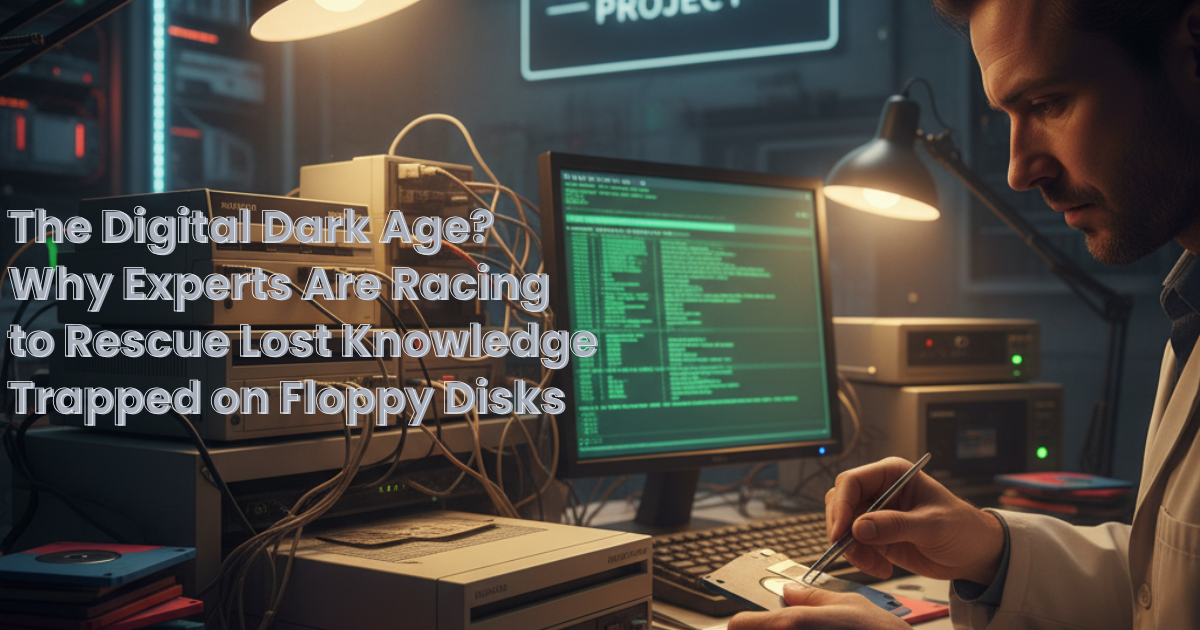The Race Against Obsolescence
The Stakes: Cambridge’s Priceless Digital Heritage
The Paradox of Preservation: Paper vs. Plastic
These rare, often one-of-a-kind manuscripts are carefully kept in climate-controlled archival environments, where staff meticulously work to prevent delicate pages from crumbling or ink from flaking. However, the venerable Cambridge University Library faced an unprecedented digital challenge when it acquired the archive of the late physicist, Stephen Hawking.
Tucked within the 113 boxes of letters, photographs, and thousands of pages relating to his seminal work on theoretical physics, were items not commonly seen in modern offices: floppy disks. These obsolete media posed a unique problem for the digital preservation team. While the paper archives are safe, the essential born-digital records of one of the world’s greatest minds were perilously close to becoming irretrievable lost data.
Hawking’s Digital Legacy: The Archivist’s Dilemma
These forgotten disks were a direct result of Stephen Hawking’s early adoption of the personal computer. Despite his struggle with Amyotrophic Lateral Sclerosis (ALS), the physicist was able to continue his groundbreaking work thanks to bespoke hardware modifications and specialized software.
Locked inside these obsolete digital carriers could be a wealth of forgotten information: unpublished writings, personal correspondence, or previously unknown insights into the scientist’s life and process. Facing this potential treasure trove of born-digital material—which was simultaneously on the verge of total decay—the archivists were confronted with the immense, yet thrilling, challenge of digital data recovery and long-term preservation.
Future Nostalgia: A Global Digital Preservation Mission
These critical disks are now central to the “Future Nostalgia” Project at Cambridge University Library, an initiative dedicated to rescuing hidden knowledge trapped on obsolete storage media.
This effort is not isolated; the “Future Nostalgia” Project reflects a larger global trend as immense quantities of born-digital information flood archives and research libraries worldwide.
”Most of the donations we get are from people who are either retiring or passing away,” explains Leontien Talboom, a leader in the library’s Digital Preservation team. “That means we’re seeing more and more things from the critical early era of personal computing.”
The Preservation Paradox: Why Digital Storage Fails
At first glance, the durable plastic shells of floppy disks, popular from the 1970s to the 1990s, might appear more secure than fragile manuscripts. After all, paper rots, ink fades, and synthetic materials can last for centuries—which is why plastic pollution is such a contemporary concern.
However, the digital information saved inside these rigid cassettes is far more vulnerable. The iron oxide coating the thin plastic layer inside can degrade and lose its magnetism over time, leading to total and irretrievable data loss.
The Challenge of Obsolescence and Access
Legacy data storage devices like floppy disks therefore present serious complications for digital archivists. As Leontien Talboom explains, the key difference lies in access dependency: “If you’ve got a book, it doesn’t matter how old it is—you can still read it [provided you understand the language it is written in, of course].”
With digital media, the problem is compounded by technological obsolescence. To access the content, researchers require highly specialized vintage hardware and drives—it’s like needing a specific key simply to open a book. Even after overcoming the hardware hurdle, Talboom notes, understanding the files remains a challenge: “You need to know a lot about the original operating systems where these floppy disks were formatted, too.”
The Looming Digital Dark Age
This complex and accelerating problem has created significant concern among archivists, historians, and archaeologists. They fear that future generations will face a “Digital Dark Age” when attempting to research the past fifty years of human history. Much like the European Dark Ages that followed the Roman Empire’s collapse, the issue isn’t that nothing happened, but that the records of human thought, feeling, and life will be permanently lost or inaccessible.
Technical Triage and Data Rescue
To counteract this threat of data extinction, the Future Nostalgia project employs highly specialized digital forensics techniques. The team must piece together bits of ancient computer hardware to successfully read rare and unusual obsolete media. Even with the correct vintage equipment, the team must laboriously determine how the disks were formatted to ensure accurate data recovery.
This process often involves delicate physical conservation as well. Team leader Leontien Talboom has found herself carefully teasing mold off the flimsy magnetic surfaces of the disks to prevent irreversible scratching. “If people have kept them in garages or lofts, they can get moldy,” she says, underscoring the poor archival conditions of much of the world’s digital heritage.
A Trove of Digital Heritage
The content recovered so far offers a tantalizing glimpse into the diverse array of material at risk. In the Cambridge University Library archives alone, Talboom has processed digital files ranging from writings and abstract lists by poet Nicholas Moore to articles from a society of the paranormal.
Yet, the Stephen Hawking disks remain her favorite. The work carries immense historical gravity, as she proudly states: “I was honored to work on them.” The team’s ongoing success ensures that these critical born-digital records will endure, transforming the challenge of obsolescence into a new chapter of long-term preservation.
The Hawking Archive: Technical Breakdown and Discoveries
The Cambridge University Library received the digital and physical contents of Stephen Hawking’s office via the Acceptance in Lieu (AIL) scheme, a critical program that ensures important historical and archival objects are made publicly accessible. Alongside the papers, letters, and printouts, the acquisition included a significant amount of born-digital material, Talboom confirms.
The Hawking disks arrived in two distinct batches, presenting different technical data recovery challenges:
The Earlier Batch (5.25-inch Disks): These disks were formatted for a DOS-based computer (“basically early Windows,” Talboom explains). Dating is difficult, as users often retained systems for many years, but these are believed to be the oldest. Research is ongoing, but Talboom has confirmed they contain personal letters written by Hawking. In a fascinating glimpse into the scientist’s famous light-hearted side, the team also recovered several early computer games from some of these disks.
The Later Batch (3.5-inch Disks): These more common disks appear to be from a later period and are associated with an early Macintosh system. They primarily contain lecture notes and speeches. “From a technical point of view, they’re really interesting,” Talboom notes, “because his lectures were so huge he had to split them over multiple floppy disks.”
Preserving the Voice of Genius
Hawking was known to write his speeches and save them directly to disk for later delivery via his famous voice synthesizer. These critical digital files may also contain folders of plain text on a wide range of issues important to the physicist, allowing him to select sections during conversation or in response to questions. Crucially, at least some of the disks also contain the specialized assistive software used by the scientist, a key component of his digital legacy that the digital preservation team is working to secure.
The Technical “Wild West” and Hardware Scarcity
The variations in disk size, formatting, and required software for the Hawking material are highly characteristic of the early floppy disk era. “There wasn’t one system that dominated the market,” Talboom explains. “It was a bit of a Wild West out there.”
For digital archivists today, this technical diversity necessitates maintaining a vast inventory of specialized, decades-old machines to read various disk sizes and file systems. Sourcing this obsolete computing hardware requires significant searching, often leading experts to unusual places, from estate auctions to online collector marketplaces.
The Kinnock Case: Unlocking Political History
Chris Knowles, a key contributor to the Future Nostalgia project, recounts the challenge: “I bought my eight-inch drive off eBay,” he says. “It was a miracle that it worked.” Knowles is utilizing this rare drive to extract content from almost 200 eight-inch floppy disks—the oldest format in the collection—for the Churchill Archives Centre.
These difficult, large-format disks were once owned by Neil Kinnock, former leader of the UK Labour Party. “At first, we thought the disks just contained speeches, which we already had in other formats,” Knowles explains. “But in doing our tests, we’ve proven that at least some of it is previously unarchived correspondence with his constituents.” This discovery underscores the high stakes of data recovery for essential historical context.
A Race Against Disappearance
Though Knowles got lucky securing a working drive for this rare disk format, Talboom emphasizes that the challenge is growing exponentially. The equipment needed to unlock the data trapped on floppy disks is rapidly disappearing. “This stuff is not going to last forever,” she warns. “Ten years ago, it would have been easier. But a lot of it is vanishing.” This increasing scarcity reinforces the urgency of the Digital Preservation movement.
The Three-Inch Quirk: Hacking the Obsolete
Among the rarest finds discovered in the Cambridge University Library collections are peculiar three-inch floppy disks. These were briefly popular in the UK before being quickly eclipsed by the 3.5-inch format that became the industry standard.
”They’re significantly more challenging because the drives are harder to acquire,” explains Talboom. The technical hurdles are complex: “They operate on a different voltage system. So there are all these kinds of quirks that need to be addressed to get them to work.”
To successfully achieve data recovery from this unique format, Talboom and her colleagues had to execute an intricate solution. This involved sourcing a specific disk drive made by Amstrad, fabricating custom new connectors, and “jerry-rigging” (or temporarily rigging) a power cable to successfully power the drive and access the data. This level of technical ingenuity is typical of the digital preservation fieldwork required to bridge the gap between obsolete hardware and modern archives.
The Digital Lexicon: Software Obsolescence
The scarcity is not limited to obsolete hardware; vital information concerning floppy disk software is also rapidly vanishing. “A lot of the people who worked on these systems have either retired or they’ve passed away,” Talboom explains, emphasizing that this essential legacy knowledge is being lost.
The Neil Kinnock disks exemplify this challenge. “The materials were very hard to get into,” Chris Knowles recounts. “They were written on the Diamond Word Processor. There’s very little documentation about that specific system out there.” Knowles points out that while fan communities exist for systems with games, lending tools to archivists, the lack of such communities for niche word processors makes the preservation effort “more awkward.”
Digital Philology: Translating the Illegible
This means that even after data extraction from a floppy disk, significant work is needed to render the files readable on a modern device. Peter Rees, an archivist at the Cambridge History of Innovation Project, aptly likens the process to a form of translation:
“Philologists go to the ancient Latin and translate it into a text we can read in the present. That’s what the Future Nostalgia project is doing with this illegible code. We have to use technical apparatus to decipher it and then make it readable.”
This stage—the crucial digital translation—is often the most difficult.
The Final Hurdle: Ensuring Accessibility
Due to the complexity of running old software on modern devices, some data recovered by the Future Nostalgia project is not yet available to researchers. “With the Stephen Hawking materials, the next part of the process is access,” Talboom states. She concludes that the need for ongoing emulation and migration means “it’s quite challenging to make them properly accessible to users,” marking the final, ongoing hurdle in the global mission of digital preservation.
The Ethics of Preservation: Maintaining Authenticity
For archivists working with archaic software, a key ethical concern is maintaining the fidelity of the original data. Chris Knowles notes that the process of using modern digital forensics tools can subtly alter the appearance or structure of the material. “We try to minimize how much we change things,” he confirms, underscoring the delicate balance between data recovery and preserving authenticity.
The Race to Save Deteriorating Media
From Banal to Breakthrough: Public Engagement
The Thrill of Digital Discovery
As for Talboom, she holds a special interest in the 5.25-inch floppy disks—one of the earliest formats and her personal favorite. She explains the allure of this specific obsolete media: “Floppy disks were really expensive at that time, so people would reuse them and overwrite them. With a 5.25-inch, you never know what you’re going to get. The label can say one thing, but something else could be inside.”
This element of mystery is a huge part of the appeal of working with these digital artifacts. “If you receive an archive of paper material, there’s probably someone who flipped through the pages,” Talboom says. “But with floppy disks, they just get handed over to us. I find it fascinating that someone put a floppy disk away 40 years ago and I’m the first one seeing it again. It feels like discovering something.”
A Window to an “Alien” Past
In an era where digital information is easily accessible anywhere in the world, Peter Rees agrees there is something deeply special about working with software and information that has lain dormant for decades.
”You might think things haven’t changed much from 30 or 40 years ago,” he says. “But floppy disks show us just how alien the past is. We have a better memory thanks to floppy disks.” The work of the Future Nostalgia Project is thus crucial, not just for data recovery, but for preserving the authentic, physical texture of our recent history and ensuring the integrity of our collective digital heritage.






